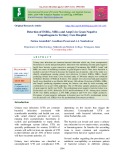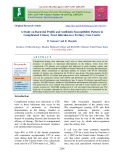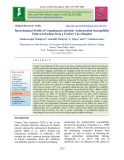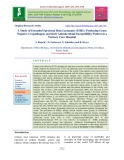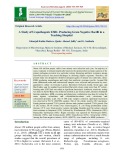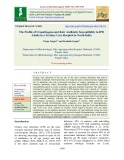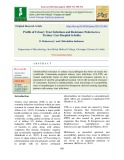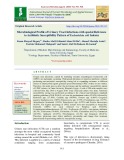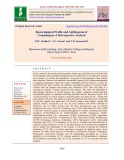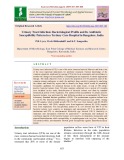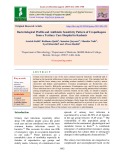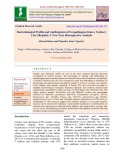
The profile of uropathogens
-
Aim of the study is to identify uropathogens causing urinary tract infection. To detect ESBLs, MBLs, AmpC producing isolates from urine. Cross sectional study of 300 urine samples was conducted in Mediciti Institute of Medical Sciences. The samples were processed and gram negative bacilli were identified as per Mackie McCarteny 14th edition. Detection of ESBLs, MBLs and AmpCs producing organisms among the isolates was done by both screening and confirmatory test as per CLSI guidelines.
 11p
11p  cothumenhmong9
cothumenhmong9
 18-01-2021
18-01-2021
 14
14
 2
2
 Download
Download
-
The main aim of this study to determine the Bacteriological profile in patients with Complicated Urinary Tract Infection and determine the Antibiotic susceptibility pattern using Kirby Bauer Disc diffusion method. Also identify the prevalence of ESBL in E. coli and Klebsiella spp by screening and phenotypic confirmatory methods. Finally, analyse the drug resistant pattern in uropathogens in cUTI.
 9p
9p  gaocaolon9
gaocaolon9
 22-12-2020
22-12-2020
 18
18
 2
2
 Download
Download
-
This retrospective study aims to analyze various uropathogens and their antimicrobial susceptibility pattern in a tertiary care hospital, which assist in selecting the most appropriate antibiotic therapy in treatment of Urinary Tract Infection.
 8p
8p  cothumenhmong7
cothumenhmong7
 09-09-2020
09-09-2020
 11
11
 1
1
 Download
Download
-
The main aim and objectives of this study includes to determine the Bacterial profile and their Anti-microbial susceptibility pattern of microbes in UTI patients and to detect and evaluate the prevalence of Extended Spectrum Beta Lactamase (ESBL) producing Gram Negative Uropathogens among the isolates. Also to determine the Antimicrobial susceptibility pattern for ESBL producers and ESBL non producers.
 9p
9p  cothumenhmong7
cothumenhmong7
 09-09-2020
09-09-2020
 17
17
 2
2
 Download
Download
-
About 150 million people suffer from urinary tract infection each year. In majority of cases, treatment is initiated empirically based on the antimicrobial resistance pattern of the urinary pathogens prevalent in a particular setting. Emerging antibiotic resistance among Enterobacteriaceae has posed challenges in choosing empiric regimens. Therefore, the present study was designed to identify etiological agents of urinary tract infections, detect ESBL producing uropathogens and study their antibiotic resistance profile.
 11p
11p  trinhthamhodang1213
trinhthamhodang1213
 30-05-2020
30-05-2020
 16
16
 0
0
 Download
Download
-
Urinary tract infections (UTI) are one of the most common infections that lead to morbidity in humans with Escherichia coli being the most common bacteria. Injudicious use of antibiotics has led to increased resistance of urinary pathogens to otherwise sensitive antibiotics hence; Knowledge of local bacteriological trend the antibiotic susceptibility pattern is a must to initiate a judicious antibiotic treatment. The study was a retrospective analysis of urine samples of IPD patients done over a period of 7 months from June 2017 to Dec 2017.
 8p
8p  nguaconbaynhay5
nguaconbaynhay5
 11-05-2020
11-05-2020
 24
24
 1
1
 Download
Download
-
Urinary tract infection (UTI) is considered as the most common bacterial infectious disease seen among the pediatric patients. Pediatric urinary tract infections are associated with high morbidity and long term complications like renal scaring, hypertension and chronic renal failure The epidemiology of UTI during childhood varies by age, gender and other factors (Bickerton and Ducket, 1985). Most commonly bacteria causes of UTI in children are members of Enterobacteriaceae, particularly uropathogenic strains of E. coli and Klebsiella spp.
 11p
11p  nguaconbaynhay5
nguaconbaynhay5
 11-05-2020
11-05-2020
 20
20
 1
1
 Download
Download
-
Antimicrobial resistance to urinary tract pathogens has been on steady rise worldwide. Community-acquired urinary tract infections (CA-UTI) are treated empirically based on their antimicrobial resistance patterns in a population of specific geographical location. Given the increased resistance of community bacteria to antimicrobials, local knowledge of susceptibility rates of uropathogens is essential for therapeutic decision making regarding patients with urinary tract infections.
 7p
7p  trinhthamhodang1212
trinhthamhodang1212
 06-04-2020
06-04-2020
 13
13
 0
0
 Download
Download
-
Urinary tract infections, caused by multidrug resistant uropathogenic Escherichia coli (UPEC) are alarmingly escalating. Widespread utilization of empirical antibiotics without performing anti-microbial susceptibility testing led to expanding resistance to different classes of antimicrobial agents generally prescribed among UPEC isolates in our country. Therefore, this study aims to detect the prevalence and the antibiotic susceptibility pattern of UPEC isolates, in Tanta University Hospitals, Egypt. A total of 200 urine samples were collected from July 2015 to August 2016.
 10p
10p  cothumenhmong4
cothumenhmong4
 25-03-2020
25-03-2020
 28
28
 2
2
 Download
Download
-
In the context of the present clinical scenario urinary tract infections are to be dealt with most frequently. The non judicious haphazard use of antibiotics is to be blamed for coming into existence of resistant microorganisms. A myriad of microorganisms cause urinary tract infections. Moreover the antibiotic susceptibility pattern of the isolated uropathogens is changing continuously.
 8p
8p  nguathienthan3
nguathienthan3
 27-02-2020
27-02-2020
 21
21
 0
0
 Download
Download
-
Urinary tract infection (UTI) is one of the most common bacterial illnesses and hence one of the most important indications for antibiotic treatment. Current knowledge of the common organisms implicated in causing UTI in the local community and surveillance to monitor the changes in susceptibility of uropathogens are imperative to ensure appropriate therapy.
 8p
8p  trinhthamhodang3
trinhthamhodang3
 12-02-2020
12-02-2020
 13
13
 1
1
 Download
Download
-
Urinary tract infection is one of the most common bacterial infections worldwide and is defined as the bacterial infiltration of otherwise sterile urinary tract. This includes both the upper and the lower urinary tract including urethra (urethritis), bladder (cystitis), ureters (ureteritis) and kidney (pyelonephritis). Common uropathogens are Escherichia coli, Enterococcus faecalis, Klebsiella pneumonia, Pseudomonas spp. and Proteus mirabilis. These infections have risk of high recurrence rates and increasing antimicrobial resistance among uropathogens has enhanced economic burden.
 9p
9p  kethamoi2
kethamoi2
 15-12-2019
15-12-2019
 27
27
 1
1
 Download
Download
-
Urinary tract infections (UTIs) are one of the most common bacterial infections encountered in clinical practice. The knowledge of etiology and antibiogram of uropathogens helps in starting empirical treatment till the results of antibiotic susceptibility is awaited. Therefore this two year retrospective study was undertaken to determine the bacteriology and antimicrobial susceptibility pattern of UTIs in a tertiary care hospital. Urine samples from patients suspected of having UTI were processed according to standard microbiological techniques.
 7p
7p  nguaconbaynhay1
nguaconbaynhay1
 04-12-2019
04-12-2019
 36
36
 1
1
 Download
Download
CHỦ ĐỀ BẠN MUỐN TÌM








